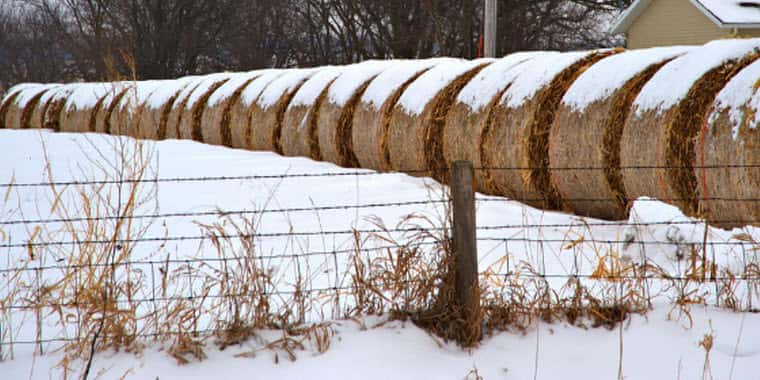BROOKINGS, S.D. – No matter what materials hay producers choose to bind forage with, the method of storage throughout the summer, into the fall and winter is important to maintaining forage quality, as well as minimizing waste and simultaneously cost of production.
To maximize quality and minimize waste, read on to learn some research-based tips on forage storage put together by Taylor Grussing, SDSU Extension Cow/Calf Field Specialist and Karla Hernandez, SDSU Extension Forages Field Specialist.
Factors Affecting Outside Storage Losses
Bale Density: With dry hay (moisture at 10-20 percent), the denser the bale, the lower the amount of spoilage. The density of round bales should be a minimum of 10 pounds of hay per cubic foot.
Field operations: Uniform swaths, sized to match the recommendations of the baler, will help produce uniform and dense hay bales.
Reduce outdoor storage loss with these tips: Outdoor hay storage, increased precipitation results in greater chance for storage losses. Stacking and storage methods noted below can help reduce outside storage loss.
Stacking: Bales should be removed from harvest areas as soon as possible in order to allow for uniform regrowth and potentially more cuttings – depending on the forage type.
Round bales that are stacked alongside harvest areas should be orientated flat end to flat end, in north and south rows. Stacking east and west will cause deterioration on the north-facing surfaces if not used before next summer.
Stacks should be placed in well drained, non-shaded areas to prevent spoilage.
It is recommended to leave three feet between rows to provide adequate air flow, sun exposure for drying and reduce excess moisture accumulation.
Reduce hay fire danger: If removing hay from the field and stacking in a hay yard, make sure bales are cool and dry to eliminate any potential heating and fire danger.
Storage: There are many storage options for hay. The more protected the storage option, typically the greater the expense. However, when penciling out expenses, the price of wasted hay isn't cheap.
Depending on how much hay is harvested and used each year, it may be cost effective to improve hay storage methods.
What can be done today?
Taking current hay prices into account, last year's decreased forage production and future forage needs, storage options may need to be re-evaluated sooner than later.
While building a barn may not be realistic this summer, take note of current stacking methods, and see if changes can be made this year to decrease waste.
In addition, document current hay inventory (accounting for some waste) and compare this to the winter hay needs of the cowherd.
If additional forage needs to be sourced, be sure to purchase quality hay confirmed with a nutrient analysis.
Lastly, begin tracking hay waste each year and compare the cost of wasted hay to the cost of improving hay storage on your farm long term.
###
SDSU iGrow




